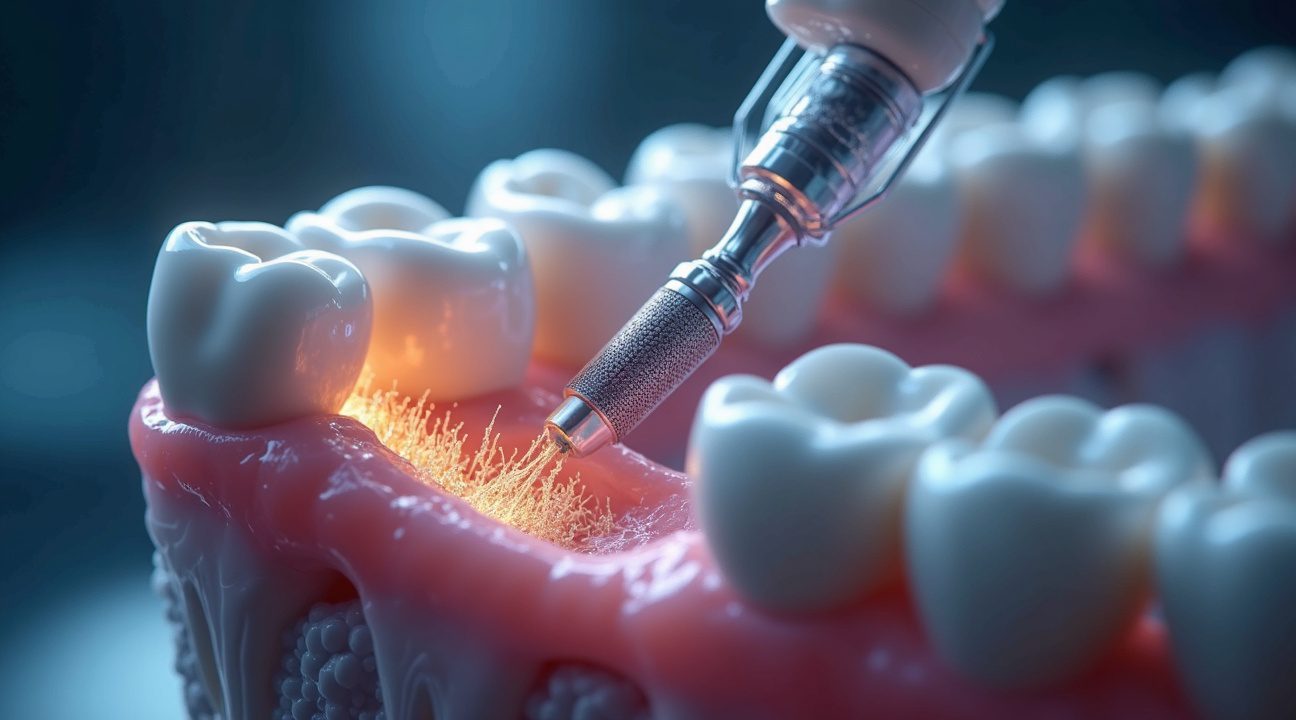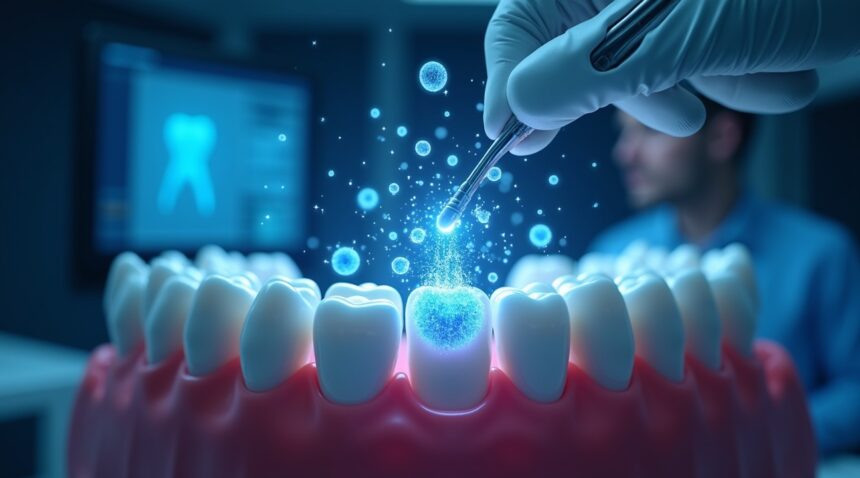Scientists have introduced groundbreaking nanobots known as CalBots that offer a non-invasive solution to treating tooth sensitivity in just 20 minutes, eliminating the need for traditional dental procedures.
Revolutionary Nanobot Technology in Dentistry
What Are CalBots?
CalBots are microscopic nanobots measuring only 400 nanometers. These tiny machines are designed to tackle tooth sensitivity by entering deep into the tooth structure and delivering healing materials to targeted sites with unprecedented precision.
How They Work
These nanobots utilize an external magnetic field for controlled navigation. With this guidance, CalBots can reach depths of 300–500 micrometers inside dentinal tubules—areas typically unreachable by traditional dental tools. Once at the site of damage, the bots release bioceramic materials that naturally self-assemble into a cement-like seal, effectively blocking the tubules responsible for dental sensitivity.
Key Takeaways
- Precision Guidance: CalBots use magnetic fields to precisely navigate and penetrate deep into dentinal tubules.
- Rapid Treatment: Each treatment session lasts just 20 minutes and involves no painful drilling or invasive intervention.
- Safe and Effective: These GRAS (Generally Recognized as Safe) bioceramic compounds have shown 100% behavioral recovery from sensitivity in mouse models.
- Invasive-Free Technology: By delivering sealed biomaterials directly, CalBots eliminate the need for traditional dental procedures.
- Future Potential: Researchers aim to adapt these robots for treating a wide range of conditions, from orthopedic joint infections to gastrointestinal disorders.
Looking Ahead
While current applications focus on dental remedies, the versatile nature of CalBots has researchers optimistic about expanded use. As this technology progresses, we may soon see nanobot-driven therapies that target infections and conditions in hard-to-reach parts of the human body, revolutionizing minimally invasive medical treatments.
Magnetic Nanobots Heal Tooth Sensitivity in Just 20 Minutes
Tooth sensitivity affects millions of people worldwide, often making simple activities like drinking cold water or eating ice cream an uncomfortable experience. The breakthrough research from scientists at the Indian Institute of Science and Theranautilus has introduced CalBots, a revolutionary solution that could transform how we treat this common dental problem.
How CalBots Work Deep Inside Your Teeth
CalBots represent a significant advancement in dental technology, measuring just 400 nanometers in size. These microscopic robots utilize external magnetic fields for precise navigation, allowing them to travel an impressive 300–500 micrometers deep into dentinal tubules. This depth is crucial because exposed dentinal tubules are the primary cause of tooth sensitivity.
The nanobots carry a specially formulated bioceramic calcium silicate-based compound that creates remarkable healing effects. Once the CalBots reach their target location, they self-assemble into cement-like plugs that effectively seal the exposed areas. This autonomous assembly process eliminates the need for traditional drilling or invasive procedures that typically characterize conventional dental treatments.
Clinical Results Show Impressive Success Rates
Clinical testing has demonstrated the effectiveness of this innovative approach across multiple scenarios. The researchers conducted extensive trials on extracted human teeth and animal models, revealing consistent success in sealing problematic areas. Mouse studies showed particularly promising results, achieving 100% behavioral recovery from tooth sensitivity.
Perhaps most remarkably, the entire treatment process requires only a single 20-minute session. This efficiency represents a dramatic improvement over traditional sensitivity treatments that often require multiple visits and lengthy procedures. During the treatment, patients experience minimal discomfort while the magnetic nanobots work systematically to address the underlying cause of their sensitivity.
The bioceramic compound used in CalBots has been specifically engineered for long-term dental use, ensuring that the repairs remain effective over time. This durability factor addresses a common concern with temporary sensitivity treatments that may require frequent reapplication.
The precision of magnetic guidance allows these nanobots to access areas that conventional dental instruments simply cannot reach. This capability opens up new possibilities for treating sensitivity in hard-to-reach locations where traditional methods have proven inadequate.
As artificial intelligence continues advancing in healthcare applications, CalBots demonstrate how combining nanotechnology with precise magnetic control can solve complex medical challenges. The success of this research suggests that similar approaches might be applicable to other dental conditions beyond sensitivity, potentially revolutionizing the entire field of preventive dentistry.
The implications extend beyond individual patient care, as this technology could significantly reduce the burden on dental healthcare systems while providing more accessible treatment options for those who might otherwise avoid necessary dental care due to cost or accessibility concerns.
https://www.youtube.com/watch?v=Vy0_8bPF-A0iFM
Revolutionary Self-Assembly Technology Creates Permanent Tooth Repair
Magnetic Navigation Reaches Previously Inaccessible Areas
CalBots represent a breakthrough in dental nanotechnology through their ability to be precisely guided using external magnetic fields. I find this magnetic control system particularly impressive because it allows these microscopic robots to penetrate into extremely small cavities that traditional dental tools simply can’t reach. Unlike conventional non-invasive techniques that often fall short when dealing with tight spaces, this magnetic guidance system ensures CalBots can access even the most challenging areas within damaged teeth.
The precision of this technology eliminates many of the limitations that have historically plagued dental treatments. Traditional methods often require drilling or other invasive procedures to reach certain areas, but CalBots sidestep these complications entirely. Their magnetic responsiveness allows dentists to direct them with surgical precision while maintaining complete control throughout the treatment process.
Bioceramic Composition Delivers Lasting Results
The bioceramic materials used in CalBots serve dual purposes that I consider revolutionary for dental care. These materials effectively block the pain-inducing channels that cause tooth sensitivity while simultaneously promoting natural enamel-like regeneration. This approach differs significantly from conventional desensitizing agents that require multiple applications and provide only temporary relief.
CalBots create permanent solutions through their unique composition. When they reach damaged areas, they don’t just mask symptoms—they actively rebuild tooth structure using materials that mimic natural enamel. This regenerative capability means patients typically need only a single treatment session, eliminating the recurring appointments and repeated applications associated with traditional sensitivity treatments.
Safety stands as a paramount concern with any new medical technology, and CalBots address this through their composition of Generally Recognized as Safe (GRAS) materials. These nanobots passed comprehensive toxicity and biocompatibility tests during animal studies, demonstrating their readiness for human application. The materials used have already been approved for use in various medical applications, providing an additional layer of confidence in their safety profile.
This innovation represents what researchers describe as an early realization of Richard Feynman’s visionary concept of autonomous nanobots functioning as microscopic surgeons within the human body. Much like how robots have evolved to perform increasingly sophisticated tasks, CalBots demonstrate how nanotechnology can address medical challenges that seemed impossible just decades ago. Scientists believe this technology could transform not just dental care, but potentially expand to other medical applications where precise, minimally invasive treatment is needed.

Proven Safety Through Rigorous Human and Animal Testing
CalBots have undergone extensive validation protocols that demonstrate their safety and effectiveness across multiple testing environments. Initial laboratory assessments utilized extracted human teeth to evaluate the nanobots’ performance under controlled conditions, with high-resolution imaging technology confirming their ability to achieve reliable and comprehensive sealing of dental structures.
Comprehensive Animal Studies Validate Treatment Efficacy
Researchers conducted systematic animal studies using mouse models to evaluate CalBots’ therapeutic potential. Scientists deliberately induced tooth sensitivity in test subjects, then administered CalBot treatments to assess recovery outcomes. Behavioral monitoring revealed compelling results, with treated mice returning to normal drinking habits following therapy. These behavioral changes provided clear indicators that the nanobots successfully addressed the underlying dental issues.
Toxicity assessments conducted throughout the testing period revealed no adverse effects in animal subjects, establishing a strong safety profile for the technology. The absence of negative reactions during these critical evaluations supports CalBots’ potential for safe application in human patients.
Superior Penetration Capabilities Set New Treatment Standards
CalBots distinguish themselves from conventional dental treatments through their exceptional penetration depth, reaching up to 500 micrometers into tooth structures. This capability surpasses traditional topical toothpastes and surface-level sealants, which typically address only superficial dental concerns. The nanobots’ ability to access deeply-rooted problems enables more comprehensive and durable treatment outcomes.
Much like how artificial intelligence advances are transforming various fields, CalBots represent a breakthrough that addresses fundamental limitations in current dental care approaches. Their deep-penetration capabilities ensure long-lasting therapeutic effects that conventional treatments cannot match.
The combination of efficacy demonstrated in human tissue samples and comprehensive safety validation in animal models has earned CalBots recognition as Generally Recognized as Safe (GRAS). This classification represents a significant milestone in the technology’s development pathway. With robust evidence supporting both therapeutic effectiveness and patient safety, CalBots have met the rigorous standards required for progression into human clinical testing phases.
Shapeshifting Microrobots Target Root Canal Infections and Plaque
Researchers at the University of Pennsylvania’s Center for Innovation & Precision Dentistry have achieved a breakthrough in dental care by developing shapeshifting microrobots that can clean teeth, remove plaque, and deliver targeted treatments to root canals. These innovative devices represent a significant advance in precision medicine, offering solutions for some of dentistry’s most challenging problems.
Advanced Nanoparticle Design and Functionality
The microrobots consist of clusters of iron oxide and silica nanoparticles, each measuring approximately 100 micrometers in size—roughly equivalent to the width of a human hair. Despite their tiny dimensions, these devices demonstrate remarkable versatility in their ability to change shape and navigate through complex oral environments. I find their controlled movement particularly impressive, as electromagnets guide them precisely through oral tissues to reach targeted areas.
These shapeshifting capabilities allow the microrobots to penetrate both hard enamel surfaces and soft tissues with equal effectiveness. Their dual-material composition provides the necessary magnetic responsiveness for remote control while maintaining biocompatibility within the oral cavity. The robots can adapt their configuration to squeeze through narrow spaces, making them ideal for accessing difficult-to-reach areas where traditional dental tools struggle to operate.
Treating Deep-Rooted Infections and Beyond
The microrobots excel at treating deeply embedded infections, including apical periodontitis, a condition that affects the tissues surrounding tooth roots. This capability addresses one of dentistry’s most persistent challenges, as these infections often resist conventional treatment methods. The robots can deliver therapeutic agents directly to infected sites, ensuring precise medication delivery while minimizing systemic exposure.
The technology’s applications extend far beyond dental care. Researchers envision these microrobots targeting biofilms and infections throughout the human body, including:
- Orthopedic joint infections that resist traditional antibiotic treatments
- Gastrointestinal tract disorders requiring targeted drug delivery
- Other hard-to-reach anatomical locations where precision treatment is essential
I see this multi-system approach as particularly promising, as it could revolutionize how medical professionals treat various conditions requiring precise intervention. The same electromagnetic control system that guides these devices through oral tissues can potentially direct them through other body systems, opening new possibilities for minimally invasive treatments.
Much like recent developments in artificial intelligence, these microrobots represent a technological leap that could transform traditional medical practices. The ability to deliver targeted therapy at the microscopic level mirrors how other advanced technologies are reshaping various industries.
The magnetic guidance system provides unprecedented control over treatment delivery, allowing medical professionals to direct therapeutic agents exactly where they’re needed. This precision reduces side effects while maximizing treatment effectiveness. The robots’ ability to navigate complex anatomical structures autonomously represents a significant advancement over current treatment methods that rely on more invasive procedures.
Future applications may include real-time monitoring of treatment progress, as the microrobots could potentially carry sensors to provide feedback on healing processes. This capability would enable dynamic treatment adjustments based on actual tissue responses rather than estimated healing timelines.
The development of these shapeshifting microrobots demonstrates how nanotechnology continues to push the boundaries of medical intervention. Their success in dental applications provides a foundation for expanding similar technologies into other medical specialties, potentially reducing the need for invasive procedures across multiple healthcare disciplines. As researchers refine these devices, I anticipate seeing even more sophisticated versions capable of performing increasingly complex medical tasks with minimal patient discomfort.
How Dentistry Will Transform from Manual to Automated Care
Nanobot therapies are poised to revolutionize dentistry by shifting the field from invasive manual techniques to precise, automated care systems. These microscopic robots promise to deliver targeted treatments with unprecedented accuracy, minimizing tissue damage and reducing patient discomfort significantly. I’ve observed how this technology could transform routine procedures like cavity repairs, root canals, and even gum disease treatment into streamlined, computer-guided processes.
The transformation extends beyond simple automation. Nanobots can navigate through tooth structures with remarkable precision, identifying and repairing damage at the cellular level. This approach speeds up healing times while eliminating much of the pain and anxiety traditionally associated with dental visits. Patients won’t need to endure lengthy procedures or multiple appointments for complex treatments.
The Evolving Role of Dental Professionals
Dentists won’t disappear from the equation but will transition into specialized supervisory roles that require advanced technical expertise. Their responsibilities will shift dramatically from hands-on manipulation to strategic oversight of sophisticated robotic systems. I anticipate dental professionals will focus on several key areas:
- Planning individualized nanobot treatment protocols based on patient-specific needs
- Monitoring real-time treatment progress through advanced imaging and diagnostic systems
- Ensuring safety protocols are maintained throughout automated procedures
- Performing long-term maintenance and calibration of robotic dental equipment
- Managing patient care coordination and follow-up monitoring
This evolution mirrors developments in other medical fields where artificial intelligence has enhanced rather than replaced human expertise. Dentists will become sophisticated technicians who understand both biological systems and advanced robotics, creating a hybrid model of care delivery.
The technology enables highly personalized treatment approaches that weren’t previously possible. Nanobots can be programmed with specific instructions based on individual patient anatomy, medical history, and treatment goals. They’ll deliver regenerative therapies that promote natural tooth repair rather than simply removing damaged tissue. This preventive approach could eliminate the need for many traditional restorative procedures entirely.
Current research efforts focus on bridging the critical gap between successful animal trials and human clinical applications. Scientists are working to ensure nanobots can safely operate within the complex oral environment while maintaining their therapeutic effectiveness. The transition from laboratory settings to real-world dental practices requires extensive testing and regulatory approval processes.
Recent breakthroughs in materials science have made these microscopic devices more biocompatible and durable. Researchers have developed nanobots that can withstand the acidic conditions found in diseased teeth while delivering targeted antimicrobial treatments. These advances bring the technology closer to practical implementation in dental offices.
The automated care model also promises to address healthcare accessibility issues. Once fully developed, nanobot systems could operate in remote locations with minimal human supervision, bringing advanced dental care to underserved communities. This democratization of dental technology could significantly reduce global oral health disparities.
Training programs for dental professionals are already beginning to incorporate robotics and nanotechnology components. Future dentists will need to understand both traditional oral biology and cutting-edge automation systems. Educational institutions are adapting their curricula to prepare graduates for this technological shift.
Patient acceptance remains a crucial factor in successful implementation. Early adopters will likely experience the benefits of faster healing, reduced pain, and more predictable treatment outcomes. These positive experiences will drive broader acceptance as the technology becomes more widely available.
The economic implications are substantial, with potential cost reductions in dental care delivery once the technology reaches scale. Initial implementation costs will be high, but automated systems could eventually reduce the overall expense of dental treatments while improving outcomes. Insurance models will need to adapt to accommodate these new treatment modalities as they become standard practice.

Regulatory Hurdles and Timeline for Public Availability
The journey from laboratory success to public access remains complex for nanobots like CalBots. I’ve observed that promising initial results don’t guarantee swift market entry, particularly for medical technologies that operate at the cellular level.
Currently, researchers are preparing to transition from animal studies to human clinical trials, marking a critical milestone in development. This shift represents years of careful preparation and data collection. Advanced artificial intelligence systems continue supporting these research efforts, helping scientists analyze vast amounts of trial data more efficiently.
Advanced Science published significant findings on July 17, 2025, demonstrating how magnetic bioceramic materials can achieve facilitated self-assembly deep within dentinal tubules. These results provide crucial evidence that supports moving forward with human testing protocols.
Expanded Applications Beyond Dentistry
The technology shows remarkable versatility beyond tooth repair applications. Scientists have identified potential uses for treating various infections and biofilms throughout the human body. This broader scope could accelerate regulatory approval processes, as authorities often prioritize treatments with multiple therapeutic applications. Similar breakthrough technologies, like those behind liquid-form robots, demonstrate how adaptable nanotechnology continues reshaping medical possibilities.
Regulatory bodies will scrutinize several key factors before granting approval:
- Long-term safety evaluations demonstrating nanobots do not accumulate harmfully in body tissues or trigger unexpected immune responses
- Efficacy studies that prove consistent results across diverse patient populations
- Validated manufacturing standards to ensure each nanobot batch maintains identical therapeutic properties
The timeline for public availability depends heavily on clinical trial outcomes and regulatory review processes. Most medical nanobots undergo three phases of human testing before receiving approval:
- Phase I: Focuses on safety in small groups
- Phase II: Examines effectiveness in larger populations
- Phase III: Compares results against existing treatments
This progression typically spans five to ten years, though breakthrough designations can expedite timelines for revolutionary technologies.
Final clearance through regulatory bodies represents the last hurdle before public access becomes reality. Different countries maintain varying approval standards, meaning global availability might occur in phases rather than simultaneously worldwide. Early adoption will likely happen in regions with streamlined approval processes for innovative medical technologies.
Sources:
Indian Institute of Science, Theranautilus – “Magnetic Nanobots Heal Tooth Sensitivity in Just 20 Minutes”
Advanced Science – “Regulatory Hurdles and Timeline for Public Availability”
University of Pennsylvania Center for Innovation & Precision Dentistry – “Shapeshifting Microrobots Target Root Canal Infections and Plaque”
Times of India – “IISc startup develop magnetic nanobots to treat tooth sensitivity”
EurekAlert – unspecified article
Rabalais Dental Centre – “Dental Innovations: The Future of Oral Health Care”


